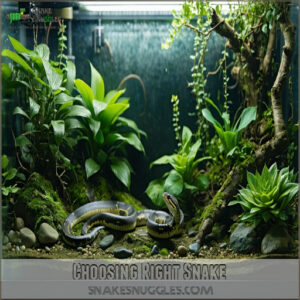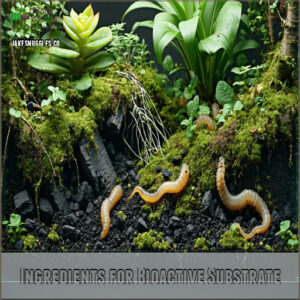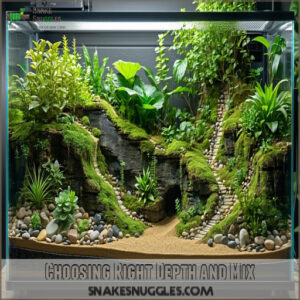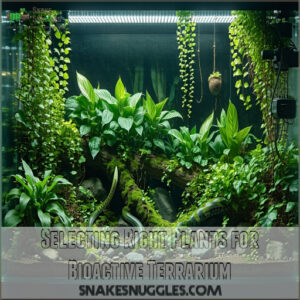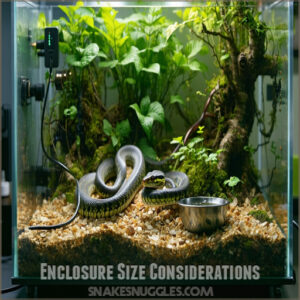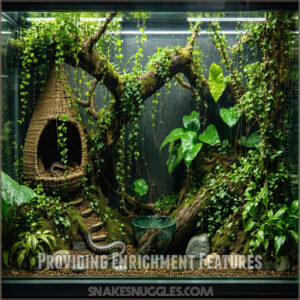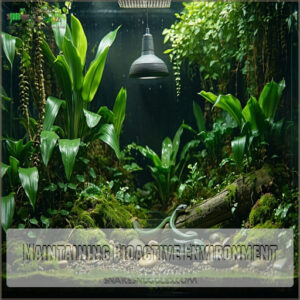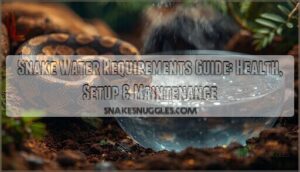This site is supported by our readers. We may earn a commission, at no cost to you, if you purchase through links.
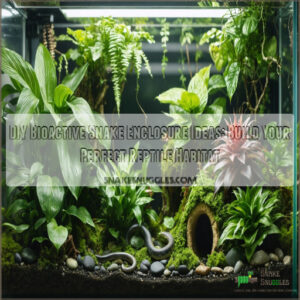 Creating a bioactive snake enclosure is easier than you’d think, and your snake will love it.
Creating a bioactive snake enclosure is easier than you’d think, and your snake will love it.
Start with a solid base: a drainage layer (like clay balls) topped with a bioactive substrate mix—coco coir, peat moss, and leaf litter work great.
Add hardy, snake-safe plants plus a clean-up crew of springtails and isopods to manage waste naturally.
Your design should reflect your snake’s lifestyle: climbing branches, burrowing spots, or hides are key.
For size, aim for 1.5-2 times your snake’s length with proper ventilation, and keep a thermal gradient for comfort.
It’s like creating a spa for your snake—minus the cucumber slices!
Table Of Contents
- Key Takeaways
- Choosing Right Snake
- Bioactive Substrate Selection
- Enclosure Size Considerations
- Enclosure Design Features
- Maintaining Bioactive Environment
- Ensuring Snake Health
- Frequently Asked Questions (FAQs)
- How to build a bioactive snake enclosure?
- How can a bioactive snake enclosure help a picky reptile?
- How do I choose a bioactive enclosure?
- How do I build a snake enclosure?
- Why should you create a bioactive corn snake enclosure?
- How to build a bioactive Python enclosure?
- What do I need for a bioactive snake enclosure?
- Are bioactive enclosures better for snakes?
- What is the best bioactive substrate for snakes?
- How deep should the substrate be in a bioactive terrarium?
- Conclusion
Key Takeaways
- Start with a drainage layer, add a bioactive substrate mix (like coco coir, peat moss, and leaf litter), and introduce a cleanup crew of springtails and isopods.
- Pick snake-safe plants, create hiding spots, and add climbing structures to reflect your snake’s natural behavior.
- Maintain a thermal gradient with a basking area and cooler side, and keep humidity between 50-70% for healthy shedding.
- Choose an enclosure size 1.5-2 times your snake’s length, ensuring room for burrowing, climbing, and exploring.
Choosing Right Snake
Picking the right snake is the first step to creating a happy, thriving bioactive enclosure.
Think about their size, temperament, and care needs—after all, you wouldn’t put a fish in a birdcage, right?
Ball Pythons as Beginner Snakes
Ball pythons are perfect for beginners thanks to their calm temperament and easy handling.
These docile snakes grow to a manageable 3-5 feet, making them ideal for small spaces.
Ball python care is straightforward, especially in a bioactive snake enclosure.
Their peaceful nature guarantees stress-free interactions, so you can focus on fun snake vivarium ideas while confidently mastering python behavior.
Corn Snakes and Their Adaptability
Corn snakes are like the Swiss Army knives of the snake world—adaptable, easygoing, and great for beginners.
They thrive in DIY bioactive terrariums thanks to their modest needs and calm behavior.
With a naturalistic snake enclosure, you can mimic their habitat while showcasing their beautiful patterns.
Plus, their easy Snake Handling makes them perfect for those new to snake vivarium ideas, and they are a great example of a species that can benefit from a bioactive terrarium.
Western Hognose Snakes and Their Quirks
Western hognose snakes are like the quirky comedians of the snake world.
Their unique traits, like playing dead or puffing up when startled, make them fascinating to observe.
They’re easy to handle, thrive in a bioactive snake enclosure, and enjoy enrichment like burrowing in substrate.
In a DIY bioactive terrarium, use snake-safe plants to mimic their naturalistic habitat.
Understanding their hognose snake care is essential for creating an ideal environment that meets their specific needs and allows them to exhibit their natural behavior, such as burrowing.
Bioactive Substrate Selection
Picking the right bioactive substrate is like baking a cake for your snake’s home—it needs the perfect mix of ingredients to stay healthy and thriving.
With the right balance of organic materials, drainage, and moisture, you’ll create a cozy, natural environment your snake will love, which is essential for its well-being and happiness, making bioactive substrate a crucial choice.
Ingredients for Bioactive Substrate
Creating a bioactive substrate starts with the right mix of ingredients.
Combine coco coir, peat moss, and leaf litter for a soft, natural base.
Add earthworm castings for nutrients and horticultural charcoal to keep things fresh.
This organic substrate mix mimics a natural environment, breaking down waste efficiently—your snake gets a comfy floor, and cleanup’s a breeze!
A bioactive substrate supports beneficial microfauna that break down waste.
Choosing Right Depth and Mix
When building your bioactive setup, substrate depth matters! Aim for 6 inches, ensuring burrowing space and moisture control.
Use a bioactive substrate mix of coco coir, peat moss, and sand for soil quality and stability. Layering techniques like adding a drainage layer also help.
Maintain balance—too much water turns it into sludge; too little, it’s arid!
Selecting Right Plants for Bioactive Terrarium
Selecting the right bioactive flora enhances your terrarium. Snake-safe plants like pothos and terrarium greens create a natural vibe while helping regulate humidity.
A bioactive enclosure utilizes soil, plants, and invertebrates to create a self-cleaning ecosystem. Stick with hardy, tropical plants your snake’s habitat resembles.
Here’s how to pick:
- Go non-toxic! Snake safe plants are key.
- Choose sturdy live plants for snakes.
- Match plants to natural habitat.
- Add grow lights.
Enclosure Size Considerations
Your snake’s enclosure needs to be big enough to let them stretch out and explore, but not so huge they feel overwhelmed.
Think of it like buying shoes—they need to fit just right, with enough room to grow comfortably!
Measuring Snake Length
A tape measure works wonders for snake length measurements. Gently stretch your snake along a straight line (while they squirm less!). Remember their tail length too—it counts.
Accurate snake sizing helps track growth rates and plan scalable designs for your DIY snake terrarium. Length measurement helps confirm the right snake enclosure size, so don’t eyeball it!
| Method | Tools Needed | Pros | Cons |
|---|---|---|---|
| Tape Measuring | Flexible tape | Simple, precise | Requires cooperation |
| String Technique | String, ruler | Good for wiggling snakes | Less accurate |
| Shed Skin Method | Shed skin, ruler | Non-intrusive | Shed might stretch |
| Photo Comparison | Camera, ruler | Visual reference | Less precise |
Accounting for Growth Space
Your snake’s growth space is like buying shoes for a growing kid—plan ahead.
Enclosure size should match the snake length at 1.5-2 times its adult size.
Ball pythons, for instance, might need scaling up as they hit 4-5 feet.
Scalable designs save hassle later, especially with fast growth rates, and a DIY snake terrarium grows smarter, not harder!
Selecting Optimal Tank Dimensions
When planning your bioactive snake enclosure, go big!
Use a tank size at least 1.5 times your snake’s length, with enough depth for climbing, hiding, and burrowing.
A 4x2x2-foot enclosure works for many species, balancing space requirements and dimension ratio.
Proper ventilation is essential for optimal enclosure dimensions.
Think of it as your snake’s cozy mansion, not just a room—roomier setups promote better movement and health.
Enclosure Design Features
You’ll want your enclosure to feel like a mini slice of your snake’s natural world, complete with places to climb, hide, and explore.
Think of it as designing the ultimate snake playground that’s both comfy and escape-proof!
Providing Enrichment Features
Keep your snake’s mind and body active with creative features.
Design enrichment zones with:
- Climbing Structures: Add branches or ramps for exercise.
- Hideout Options: Provide cozy snake hides to match their size.
- Sensory Stimulation: Include textures like smooth cork or rough bark.
- Activity Zones: Place tunnels or mazes for exploration.
- Environmental Enrichment: Rotate items occasionally to spark curiosity.
Creating Thermal Gradient and Water Features
Think of your enclosure like a cozy studio apartment for your snake.
Create thermal gradients by placing heat sources on one side for basking, leaving the other cooler. A suitable terrarium heater is essential for maintaining ideal temperatures.
Add water features, like a shallow dish or fog system, for drinking and humidity control.
Thermal monitoring maintains balanced temperature zones, helping with moisture control and preventing health issues.
Incorporating Hiding Spots and Climbing Structures
Once your gradient’s set, add some fun, include climbing rocks or branch designs for vertical spaces—snakes love exploring.
DIY hiding spots like snake tunnels or hideout boxes give them privacy, for a polished look, blend these into your terrarium background ideas.
A creative snake enclosure design also serves to keep your pet happy and wows visitors.
Maintaining Bioactive Environment
Keeping a bioactive enclosure thriving isn’t hard, but it does take some regular care.
You’ll rely on tiny cleanup crews, like springtails and isopods, plus consistent monitoring of temperature and humidity to keep things balanced and healthy, which is crucial for maintaining a bioactive enclosure.
Springtails and Isopods for Waste Management
To keep your bioactive enclosure tidy, springtails and isopods act like tiny janitors, munching on waste and mold.
These clean-up crew champs also aerate the bioactive substrate and improve soil health.
- Springtail Breeding: Easy to start, they multiply fast.
- Isopod Care: Provide moisture and hiding spaces.
- Bioactive Maintenance: Check the terrarium drainage layer to prevent flooding.
Fungi and Other Organisms for Breakdown
Imagine fungi as nature’s cleanup crew in your bioactive enclosure.
They break down organic matter like leaf litter and bits of waste, fueling the decomposition process. This supports fungal diversity and balances microbes.
Beneficial organisms thrive, cycling nutrients for plants.
| Benefit | Fungal Role | Targeted Material | Outcome |
|---|---|---|---|
| Nutrient recycling | Breaking down debris | Leaf litter, waste | Enriched soil |
| Biodiversity boost | Supporting microbe types | Biodegradables | Healthy ecosystem cycling |
| Mold prevention | Stabilizing microbes | Organic buildup | Balanced microbe balance |
| Plant growth support | Providing soil nutrients | Decomposed organics | Thriving plants |
Monitoring Temperature and Humidity Levels
A happy snake starts with a cozy climate! Temperature control is key—use thermostat control and heat sources to maintain a steady gradient, like 85°F on one side and 75°F on the other.
Proper substrate depth is essential for burrowing and plant support.
Humidity sensors help keep levels around 50-60%. Ventilation systems prevent stuffiness, while regular climate monitoring makes sure no surprises.
Your snake’s comfort? Safe and snug!
Ensuring Snake Health
Keeping your snake healthy means more than just feeding it—watching for signs of illness, like trouble shedding or breathing, is key.
Think of it as being a detective for your pet, where quick action can make all the difference.
Common Health Issues in Snakes
If your snake’s wheezing or struggling to shed fully, it’s likely dealing with respiratory issues or skin problems.
Prevent scale rot and skin infections by monitoring humidity.
Parasite control is critical—snake mites spread fast!
Nutritional deficiencies can fuel metabolic diseases, so offer proper food.
Anorexia in snakes can be a sign of underlying health problems, learn more about common snake health issues.
Address problems early to keep your slithery buddy safe and healthy.
Recognizing Signs of Illness
Spotting snake illness early saves a ton of trouble.
Watch for these signs:
- Respiratory issues: Wheezing or open-mouthed breathing? That’s a red flag.
- Skin infections: Check for scale rot, lesions, or mites.
- Behavioral changes: Skipping meals or hiding excessively? Something’s up.
Regular checks keep your snake thriving.
Think of it as a vet visit minus the awkward waiting room!
Preventing Respiratory Problems
Respiratory problems can sneak up, but they’re preventable.
Maintain a healthy environment with proper ventilation systems and airflow optimization.
Check temperature gradients (cool 75°F, basking 85°F) and humidity control (40-60%).
Poor air quality harms snakes, so keep ventilation strategies in mind.
Think of it like fresh air for you—it helps your snake breathe easy and thrive.
| Problem | Cause | Solution | Tools Needed |
|---|---|---|---|
| Respiratory issues | Poor ventilation | Install vents or fans | Small fans, vent covers |
| Breathing trouble | High humidity (70%+) | Adjust misting frequency | Hygrometer, sprayer |
| Stress coughing | Temperature fluctuations | Create temperature gradient | Thermometers, heat mats |
| Mold in enclosure | Over-misting or stagnant air | Improve airflow, reduce misting | Cleaning supplies, fans |
Respiratory issues, such as breathing trouble, can be caused by poor ventilation, high humidity, or temperature fluctuations.
The provided table outlines common problems, their causes, and effective solutions.
To address these issues, it’s essential to have the right tools and strategies in place, including vents, fans, hygrometers, and thermometers.
Regular maintenance and monitoring can help prevent respiratory problems and ensure a healthy environment for your snake.
Promoting Healthy Shedding
To promote healthy shedding, keep your bioactive snake enclosure’s humidity between 50-70%.
Toss in shedding aids like moist hide boxes or sphagnum moss pockets—they’re like mini spas for your snake.
Maintain proper moisture levels with regular misting and keep a temperature gradient for comfort.
A soft, absorbent substrate choice also supports skin health by preventing dryness or irritation, and can be considered a shedding aid, similar to using sphagnum moss.
Frequently Asked Questions (FAQs)
How to build a bioactive snake enclosure?
Start with a sturdy tank, layer drainage, bioactive substrate, and leaf litter, then add plants like pothos.
Include hides, climbing spots, and a water bowl.
Introduce springtails and isopods for waste management—nature in action!
How can a bioactive snake enclosure help a picky reptile?
A bioactive enclosure caters to picky reptiles by mimicking their natural habitat, offering familiar textures, humidity, and scents.
The clean-up crew manages waste, while live plants create a calming environment, encouraging natural behaviors and better appetite, which is a key aspect of a bioactive enclosure.
How do I choose a bioactive enclosure?
Choosing a bioactive enclosure is like picking a home for your snake that works smarter, not harder.
Look for sturdy materials, proper ventilation, and size.
Add drainage layers, live plants, and a clean-up crew.
How do I build a snake enclosure?
Building a snake enclosure starts with sturdy materials like PVC or glass.
Add secure latches, temperature control, and a comfy substrate.
Include hides, climbing spots, and proper lighting.
Think escape-proof—you don’t want surprises, and make sure to consider complete concepts when designing the enclosure.
Why should you create a bioactive corn snake enclosure?
Creating a bioactive corn snake enclosure keeps your snake happy and stress-free, mimicking their natural environment.
It’s like giving them a tiny jungle.
Plus, cleanup’s easier with springtails and isopods handling waste naturally.
How to build a bioactive Python enclosure?
Start with a sturdy enclosure, add 3 inches of drainage, and 6 inches of organic substrate.
Include snake-safe plants, a clean-up crew, and proper ventilation.
Maintain humidity, monitor temperature, and create hideouts for your python’s comfort.
What do I need for a bioactive snake enclosure?
First, focus on function and flair! You’ll need a sturdy enclosure, organic substrate layers, live plants, a clean-up crew (like isopods), heat sources, and humidity controls to mimic nature.
It’s science meets home décor!
Are bioactive enclosures better for snakes?
Bioactive enclosures are better for your snake’s health and happiness.
They mimic natural habitats, encourage natural behaviors, and save you work with cleanup crews.
Think of it as creating a luxury resort for your slithery roommate!
What is the best bioactive substrate for snakes?
The best bioactive substrate for snakes blends coco coir, peat moss, and an ABG mix.
Add a drainage layer and top with leaf litter.
It mimics nature, promotes humidity, and lets cleanup crews thrive, with the best bioactive substrate.
How deep should the substrate be in a bioactive terrarium?
Did you know improper substrate depth can stress snakes?
Aim for 4-6 inches—or 8 inches for diggers like hognose snakes.
This depth helps burrowing, moisture retention, and supports plants, think of it as nature’s carpet!
Conclusion
Worried it’s too hard to set up? A DIY bioactive snake enclosure is simpler than it sounds!
By choosing the right substrate mix, hardy plants, and a cleanup crew of springtails and isopods, you’ll create a self-sustaining mini-ecosystem.
Add climbing branches, burrowing spots, and proper hides to keep your snake happy. Don’t forget a thermal gradient and plenty of space to match its size.
Your snake will thrive in its customized “spa” habitat! Give it a try today!
- https://www.terrariumquest.com/vivarium/bioactive/
- https://www.zoolabuk.com/post/how-to-improve-your-reptile-s-life-with-bioactive-enclosures
- https://www.reddit.com/r/snakes/comments/wo3ivk/what_lightingheating_do_i_need_for_bioactive/
- https://www.zenhabitats.com/blogs/reptile-care-sheets-resources/easy-diy-reptile-enclosure-enrichment-for-snakes
- https://www.thebiodude.com/collections/bioactive-snake-terrarium-kits

